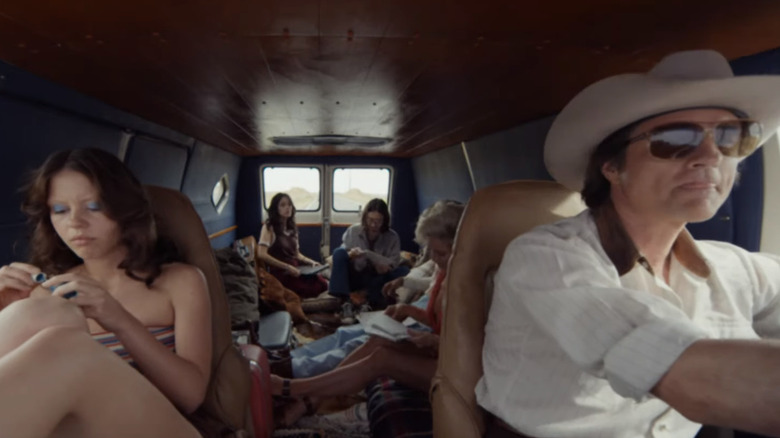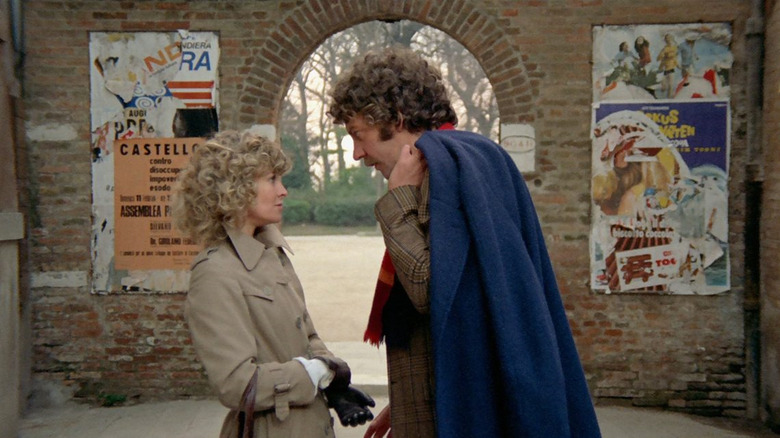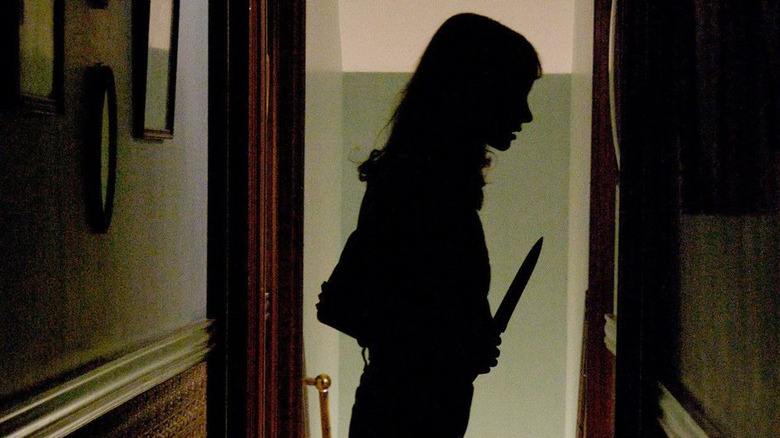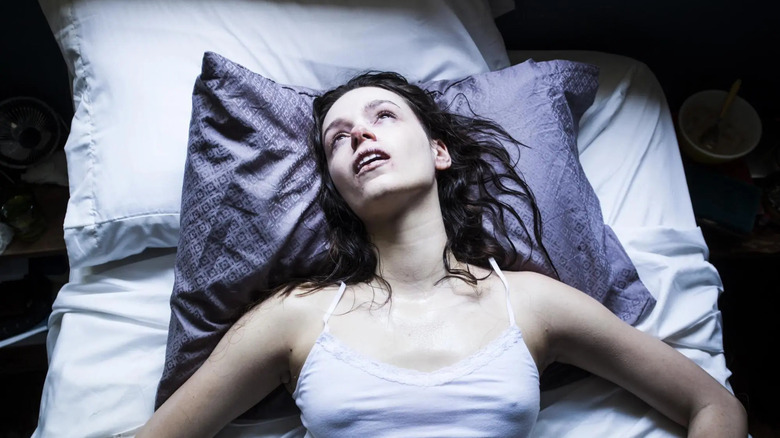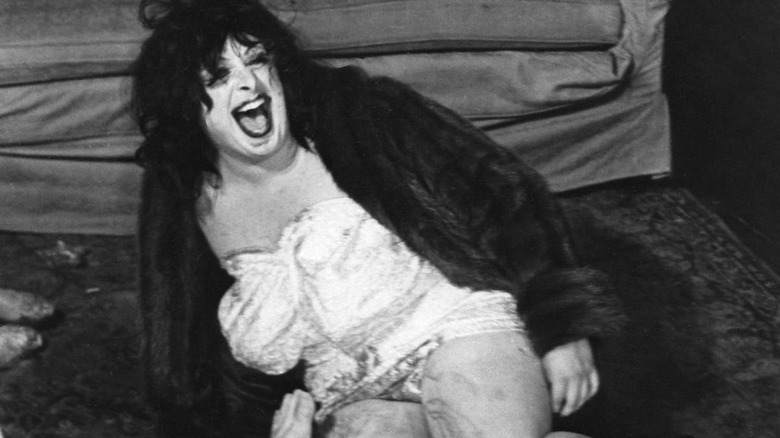Movies To Watch If You Liked Ti West's X
Ti West's "X" is a welcome balm for movie buffs who are tired of content over substance. Utilizing two disregarded lowbrow genres — porn and horror — the director of "The Innkeepers" returns with this patient, gory, intimate, and foul exercise in storytelling. "X" concerns a group of young, hungry creatives who rent the worst Texas room one could find in 1979 and attempt to shoot an artful pornography film on the premises; director RJ (Owen Campbell) aims to make the skin flick "a piece of cinema," but the homeowners have other designs on the cast and crew.
So far, "X" is one of the most entertaining movies of 2022 and is, as one character describes, "one goddamn f***ed-up horror picture." The film has been thrilling audiences since its March release, including /Film's own Matt Donato; there's a prequel on the way, but it won't arrive for a hot minute. For those who dug the movie and want more like it, worry not: recommendations are on the way.
Don't Look Now
"X" has been compared to "The Texas Chain Saw Massacre," mostly for the vibes it evokes (there are no chainsaw massacres in "X"). West makes up for the lack of Leatherface by filming a love letter to the visionary cinema of the 1970s. He told Collider:
"Because the movie was going to be craft driven and filmmaking driven, I would say that the 1970s is probably as lauded of a time in American cinema as there is. And it's a time where successful movies were also a little experimental and were oftentimes filmmaker-driven and cinema driven. It just is the decade of that, so it made sense to me."
There is plenty of movie fare to appreciate from the decade that saw the rise of New Hollywood filmmakers like Martin Scorsese and Francis Ford Coppola. For horror of the era that isn't "The Exorcist" or, well, "The Texas Chain Saw Massacre," look no further than Nicolas Roeg's 1973 giallo-adjacent thriller "Don't Look Now." Starring Donald Sutherland and Julie Christie as grieving parents working in Venice following the accidental death of their daughter, the movie is based on Daphne du Maurier's short story and features elements of Alfred Hitchcock's filmmaking style (he who adapted du Maurier's stories into "The Birds," "Jamaica Inn," and the Oscar-winning "Rebecca") on top of the fugue-state delirium that would come to characterize giallo horror of the era — plus Ti West has named it as a favorite, to boot. Resist researching the film before watching, or else the shocking ending may be spoiled.
The House of the Devil
For those enamored by West's visual style and patient storytelling, "The House of the Devil" is the logical next step. West has the wild idea of spending quality time with his most doomed characters, leading to movies that are more journey than destination; the horror comes secondary to something more universal, similar to the way that "Hereditary" is a family drama before Paimon shows up. Released in 2009, "The House of the Devil" begins with a young broke college student (Jocelin Donahue) in a state of transition, weathering bills and bad situations before she even gets a mysterious babysitting gig. As with "X," the director plays in the sandbox of the era, utilizing film grain, freeze-frames, and zooms as filmmakers of the '70s and '80s did while throwing in curveballs to throw horror-savvy audiences off. Come for the needle drops, stay for Tom Noonan.
Starry Eyes
"I need to be famous, Wayne," Maxine Minx (Mia Goth) says to her producer boyfriend, "All the best people are." She's come to rural Texas to shoot a naughty movie, and with a little powder bump and a pep talk before the mirror, she's ready for her close-up. Like Maxine, the cast of the film-within-the-film all have big ambitions and are all voluntarily doing the movie for individual reasons, and all are interrupted by violence. This is usually the purview of dramas, but horror has plenty of ways to talk about the life cycle of ambition and the systems that snuff it out. An indie favorite helmed by Kevin Kölsch & Dennis Widmyer — the duo behind the "Pet Sematary" remake — "Starry Eyes" is best described as Chris Evangelista does: "'A Star is' Born" with less singing and more body horror." Set in Tinseltown where dreams go to die, struggling actor Sarah Walker (Alexandra Essoe) makes a classic Faustian deal to finally catch her big break, and she gets it — kind of. Like "X," "Starry Eyes" is light on jump scares and heavy on sudden, climactic ultraviolence, featuring an impressive performance from Essoe -– no surprise, considering her phenomenal turn in Mike Flanagan's genre effort "Doctor Sleep" (not to mention her collaborations with Flanagan in "Midnight Mass" and "The Haunting of Bly Manor").
Multiple Maniacs
You want transgression, you've got it. Featuring frontal male nudity, lots of sexy time, and enough arterial blood to spray-paint the Alamo, West might be called a shock artist for "X" -– which wasn't his aim. He compared expectations vs. the reality of the script to Collider:
"There was a movie when I wrote this movie that people had in their head that they were terrified I could be making and then the movie that it actually is, and that was important to me that it be like, no, this is a fun and sort of charming movie, not a dark, nihilistic movie."
For those who love to sit with their discomfort and those who appreciate the beauty in the perverse, John Waters is your master of ceremonies. From "Female Trouble" to "Pink Flamingos" and beyond, the Baltimore director enjoys upending propriety and elevating sleaze, making his movies a work of art all on their own. The most like "X" is Waters' "Multiple Maniacs," a 1970 masterpiece starring Divine and her Cavalcade of Perversion in a festival of depravity wrapped in a black comedy. Therein: mass murder, glue-sniffing fiends, deviancy and enough sex-crazed blasphemy to make Ken Russell blush (trigger warning: there is also sexual assault). Call it lowbrow all you want, but the latte-swilling powers that be have since added "Multiple Maniacs" to the Criterion Closet under the distributor's umbrella of "important classic and contemporary cinema." So there.
